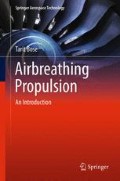Abstract
The earliest efficient reversible thermodynamic cycle was proposed by Nicolas Léonard Sadi Carnot (1796–1832) with two isotherms and two isentropes in a cycle, but it remained mostly a curiosity until today. One of the earliest engine types used for aircraft applications was piston engines running on Otto and diesel cycles. The inventor of the Otto engine, Nicholas A. Otto (1832–1891), built a successful engine in 1876. These engines helped drive the Industrial Revolution in Europe. However, the workshops had low roofs, and some early engines built vertically required holes in the roof. In the absence of spark-plugs, ignition was done by positioning a flame near the top of the cylinder and a sliding valve would open to ignite the air–fuel mixture. There was no crank shaft, and the force of the cylinder was transferred through an arrangement of linear gear and some “catcher” pins to transfer the linear motion to a rotary motion. Sometimes the “catcher” would fail and the linear rod would go through the hole in the roof. Later these engines were built with a horizontal axis. Such early engines are on display at the German Museum in Munich, Germany. The inventor of the diesel cycle, Rudolf Diesel (1853–1913), was born in Paris to German parents who later moved to London because of Franco-Prussian War in 1870. He built the first engine in 1893 in MAN’s German factory in Augsburg. Diesel planned initially to build an engine based on an earlier proposal of the reversible Carnot cycle, which was to have the best thermodynamic efficiency within a given temperature ratio. He realized very quickly, however, that to realize a Carnot cycle, one would have to run the thermodynamic process of two isotherms as slowly as possible, but in an actual engine the two adiabatic processes must be run as fast as possible, with the result that the two opposite requirements cannot be satisfied. Further, he realized that the Carnot cycle, in spite of the best thermodynamic efficiency, has a very small specific work output. On the other hand, an Otto cycle, because the air and fuel are premixed, could have a very low compression ratio with the resultant low thermodynamic efficiency. Diesel therefore proposed a cycle consisting of two adiabatic processes: one constant-pressure and one constant-volume. Diesel disappeared in 1913 while crossing the English Channel during a storm.
An erratum to this chapter is available at http://dx.doi.org/10.1007/978-1-4614-3532-7_12
An erratum to this chapter can be found at http://dx.doi.org/10.1007/978-1-4614-3532-7_12
Access this chapter
Tax calculation will be finalised at checkout
Purchases are for personal use only
Author information
Authors and Affiliations
Rights and permissions
Copyright information
© 2012 Springer Science+Business Media, LLC
About this chapter
Cite this chapter
Bose, T. (2012). Introduction. In: Airbreathing Propulsion. Springer Aerospace Technology. Springer, New York, NY. https://doi.org/10.1007/978-1-4614-3532-7_1
Download citation
DOI: https://doi.org/10.1007/978-1-4614-3532-7_1
Published:
Publisher Name: Springer, New York, NY
Print ISBN: 978-1-4614-3531-0
Online ISBN: 978-1-4614-3532-7
eBook Packages: EngineeringEngineering (R0)

